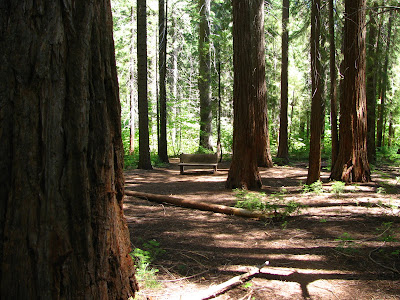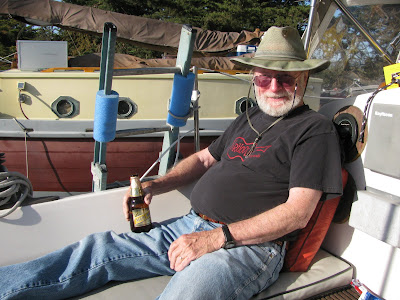 This December was more like a warm Fall.
This December was more like a warm Fall. Last year we had snow, and more came almost every day.
Last year we had snow, and more came almost every day. The snow was thin in this picture, but it got much deeper!
The snow was thin in this picture, but it got much deeper!Camp Connell, CA -- The Christmas season has been different, mostly for good reasons.
The weather has been unseasonably mild and dry. For those of you who recall last year's winter-from-Hell, that is quite a change.
My memory is that we spent most of the days between Christmas and New Years without power while snow came down and down and down. A couple of pictures will illustrate what it looked like last December.
Then this year we had an early snow, but less than a foot, and then it went away.
This week the nearby state park is crowded with visitors in shirtsleeves and tennis shoes, and there is not a sign of snow anywhere.
Another change is that this year Pat and I encouraged, and our family cooperated, giving gifts to people most in need. So while the family still exchanged small gifts, money went to the local Food Bank, and another family gift went to buy 50 meals for people somewhere in the world who are hungry. This is a good year for that.
And this year Pat and I were blessed to have Zack and Ruth and Brian and Katie and Delaney and Connor all here together.
This year we did not have to travel any further than Ruth and Brian's home 20 miles away, in sharp contrast to years past when we went from Florida to Atlanta, or the farm in Alabama, or some other distant point. Nothing can spoil a holiday quicker than sitting in an airport watching the rain, sleet and snow fall while waiting for a delayed flight.
I recall just a few years ago (40 or so) when I traveled to Birmingham to spend Christmas with my sister's family. Her husband got his first set of golf clubs, so we immediately took off that morning, found a golf course, and played a round in the snow.
Then there was a Christmas in Florida (1968) when an Apollo spacecraft was circling the moon and Pat and I were both working every day and night. Our tree was up, and partially decorated, and we never finished because we had to run off for work. We did have the pleasure of hosting Louis DeRoche of Agence France Presse as a dinner guest, a brief respite before we all went back t0 work. But our work that year included listening to Astronaut Frank Borman reading the Bible while circling the moon, something we will never forget.
Other Christmases were quieter and more normal. We went to my sister's Alabama farm a few times. Her house was always warm and welcoming, the food good and plentiful, and the children excited beyond all hope. Santa always made it, and one year my nephew taught me how to pay a new game on the television set, an astonishing invention called Mario Brothers.
Several years were spent in Florida, where Christmas weather was always a curiosity. Some years we went fishing on Christmas day, or just for a ride in the boat. Other years we watched our first child crawl around the carpet while the grandparents watched.
In later years we adapted to Ohio Christmases (stay indoors due to icy roads) and California Christmases (anything from fog to warm sunshine).
Our children's grandparents are missing now, as is my sister and any number of friends, but we were lucky enough this year to hear good news from friends all over the place and to be surrounded by all our children and grandchildren.

You can't beat that for good weather and good memories.
 I said "Grin!" and they did!
I said "Grin!" and they did!


















































